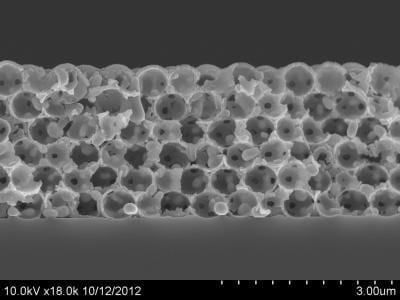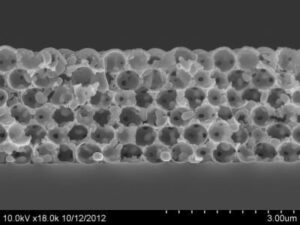“That raises the theoretical efficiency of the cell to 80 percent, which is quite remarkable.”
Scientists have created a heat-resistant thermal emitter that could significantly improve the efficiency of solar cells. The novel component is designed to convert heat from the sun into infrared light, which can than be absorbed by solar cells to make electricity – a technology known as thermophotovoltaics. Unlike earlier prototypes that fell apart at temperatures below 2200 degrees Fahrenheit (1200 degrees Celsius), the new thermal emitter remains stable at temperatures as high as 2500 F (1400 C). “This is a record performance in terms of thermal stability and a major advance for the field of thermophotovoltaics,” said Shanhui Fan, a professor of electrical engineering at Stanford University.
Fan and his colleagues at the University of Illinois-Urbana Champaign (Illinois) and North Carolina State University collaborated on the project. Their results are published in the October 16 edition of the journal Nature Communications. A typical solar cell has a silicon semiconductor that absorbs sunlight directly and converts it into electrical energy. But silicon semiconductors only respond to infrared light. Higher-energy light waves, including most of the visible light spectrum, are wasted as heat, while lower-energy waves simply pass through the solar panel. “In theory, conventional single-junction solar cells can only achieve an efficiency level of about 34 percent, but in practice they don’t achieve that,” said study co-author Paul Braun, a professor of materials science at Illinois. “That’s because they throw away the majority of the sun’s energy.”
Thermophotovoltaic devices are designed to overcome that limitation. Instead of sending sunlight directly to the solar cell, thermophotovoltaic systems have an intermediate component that consists of two parts: an absorber that heats up when exposed to sunlight, and an emitter that converts the heat to infrared light, which is then beamed to the solar cell. “Essentially, we tailor the light to shorter wavelengths that are ideal for driving a solar cell,” Fan said. “That raises the theoretical efficiency of the cell to 80 percent, which is quite remarkable.” So far, thermophotovoltaic systems have only achieved an efficiency level of about 8 percent, Braun noted. The poor performance is largely due to problems with the intermediate component, which is typically made of tungsten – an abundant material also used in conventional light bulbs. “Our thermal emitters have a complex, three-dimensional nanostructure that has to withstand temperatures above 1800 F (1000 C) to be practical,” Braun explained. “In fact, the hotter the better.”
In previous experiments, however, the 3D structure of the emitter was destroyed at temperatures of around 1800 F (1000 C). To address the problem, Braun and his Illinois colleagues coated tungsten emitters in a nanolayer of a ceramic material called hafnium dioxide. The results were dramatic. When subjected to temperatures of 1800 F (1000 C), the ceramic-coated emitters retained their structural integrity for more than 12 hours. When heated to 2500 F (1400 C), the samples remained thermally stable for at least an hour. The ceramic-coated emitters were sent to Fan and his colleagues at Stanford, who confirmed that devices were still capable of producing infrared light waves that are ideal for running solar cells.
“These results are unprecedented,” said former Illinois graduate student Kevin Arpin, lead author of the study. “We demonstrated for the first time that ceramics could help advance thermophotovoltaics as well other areas of research, including energy harvesting from waste heat, high-temperature catalysis and electrochemical energy storage.”
Go deeper with Bing News on:
Thermophotovoltaic
- 11 American Companies On the Cutting Edge of Renewable Tech
24/7 Wall St. Posted: April 19, 2024 | Last updated: April 19, 2024 Happy Earth Day! In celebration of this planet we call home, we wanted to highlight some of the companies that are pushing ...
- MIT Technology Review
Antora Energy is aiming to use thermophotovoltaic materials to turn heat stored in its carbon blocks back into electricity. Some companies plan to offer a middle path, delivering a combination ...
- £1.1m awarded to solar energy capture project
Dr Daniel Ho, co-principal investigator from Northumbria University, said: "Northumbria is at the forefront of thermophotovoltaic research, utilising a specialised microscope heating stage alongside ...
- MIT Technology Review
The company is also aiming to turn that heat back into electricity using thermophotovoltaic technology. While many companies want to install their storage solutions in industrial facilities ...
- Scalable Irish technologies that can combat the climate crisis
The team at Pyramp — a soon-to-be spun-out venture from TU Dublin, Ireland, has developed a new thermophotovoltaic (TPV) technology to generate electricity from industrial waste heat.
Go deeper with Google Headlines on:
Thermophotovoltaic
[google_news title=”” keyword=”Thermophotovoltaic” num_posts=”5″ blurb_length=”0″ show_thumb=”left”]
Go deeper with Bing News on:
Solar cell efficiency
- Cell prices fell, production schedules of module fell further
Solar cell prices fell. The current price of high-efficiency PERC182 cells (efficiency of 23.2% and above) is 0.32-0.33 yuan/W; the price of PERC210 cells is about 0.35-0.36 yuan/W; the price of ...
- Scientists make advancements with groundbreaking binary organic solar cell technology: 'Highly efficient and stable'
The scientists are improving the technology while also making the cells easier to place. Scientists make advancements with groundbreaking binary organic solar cell technology: 'Highly efficient and ...
- Longi announces 27.30% efficiency for heterojunction back contact solar cell
The Chinese module manufacturer said the new efficiency record was confirmed by Germany’s Institute for Solar Energy Research (ISFH).
- LONGi Sets New World-Record for Silicon Solar Cell Efficiency, Launching 2nd Generation Ultra-Efficient BC-Based Module
featuring industry-leading silicon solar module conversion efficiency of up to 24.43% The announcement represents the 17 th time that the company has set a world-record in solar cell efficiency since ...
- Researchers identify cause of electron-hole separation in thin-film solar cells to increase solar cell efficiency
A team of researchers have collaborated to characterize electron-hole separation in the light-absorbing layer of kesterite thin-film solar cells. This study is expected to improve the efficiency of ...
Go deeper with Google Headlines on:
Solar cell efficiency
[google_news title=”” keyword=”solar cell efficiency” num_posts=”5″ blurb_length=”0″ show_thumb=”left”]












